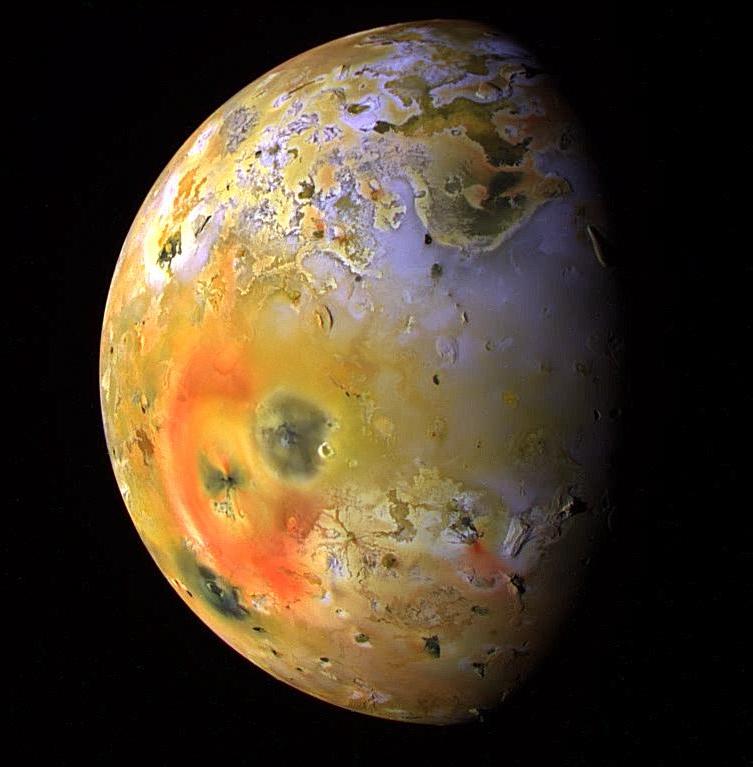Media release
From:
Sulfur and chlorine isotopes in the atmosphere of Jupiter’s moon Io indicate that it has been volcanically active for the entire 4.57 billion-year history of the Solar System, according to a new study. The findings offer new insights into the moon’s history. Io is the most volcanically active body in the Solar System. This extreme level of volcanic activity is the result of tidal heating from friction generated within the moon’s interior as it is pulled between Jupiter and its neighboring moons of Europa and Ganymede. However, how long Io has hosted such extensive volcanism isn’t fully understood. Due to the moon’s current level of volcanic activity, the surface of Io is constantly being reworked, leaving a geological record of only the most recent million years of its history. Stable isotopic measurements of volatile elements in Io’s atmosphere could provide information on the history of volcanism on Io. Katherine de Kleer and colleagues used the Atacama Large Millimeter/submillimeter Array (ALMA) to observe the gasses in Io’s tenuous atmosphere and determine the stable isotopic radios of sulfer- and chlorine-bearing molecules. de Kleer et al. found that both elements are highly enriched in heavy isotopes compared to average Solar System values due to the loss of lighter isotopes from the upper atmosphere as material is continuously recycled between Io’s interior and atmosphere. The findings indicate that Io has lost 94% to 99% of the sulfur that undergoes this outgassing and recycling process. According to the authors, this would require Io to have had its current level of volcanic activity for its entire lifetime.
Expert Reaction
These comments have been collated by the Science Media Centre to provide a variety of expert perspectives on this issue. Feel free to use these quotes in your stories. Views expressed are the personal opinions of the experts named. They do not represent the views of the SMC or any other organisation unless specifically stated.
Dr Ery Hughes, Volcanic Fluid Geochemist, GNS Science, comments:
Io is a moon of Jupiter and is the most volcanically active body in our solar system. Io is in orbital resonance with two other large moons of Jupiter, Europa and Ganymede. Every time Ganymede orbits Jupiter once, Europa orbits twice, and Io orbits four times.
This configuration causes Io’s orbit around Jupiter to be elliptical rather than circular, cyclically changing Jupiter’s gravitational pull on Io. This change in gravitational pull causes what we call tidal heating in Io, just like how the Moon causes ocean tides on Earth, which then causes the volcanism.
However, it is unclear long volcanism has been occurring on Io and how this behaviour might have varied over Io’s 4.57-billion-year history. Io has volcanism on such an extreme scale that Io’s surface renews all the time, leaving little trace of the past. Luckily, investigating sulfur and its isotopes allows us to probe back in time on Io.
Sulfur is released from Io’s interior to the atmosphere by tidal heating through volcanism. Some of the sulfur is lost to space due to Jupiter’s magnetosphere, a bunch of charged particles whirling around Jupiter that hit Io’s atmosphere continuously. The sulfur that’s left behind is eventually buried back into Io’s interior, ready to start the cycle all over again. Isotopes of the same element have different weights to each other and therefore can behave slightly different during this cycle.
It turns out that the sulfur that is lost to space on Io is a little bit isotopically lighter than the sulfur that is recycled back into Io’s interior. Because of this, over time, the sulfur left on Io gets isotopically heavier and heavier. How much heavier depends on how long volcanism has been occurring for.
Using the Chilean-based Atacama Large Millimeter/submillimeter Array (ALMA) to remotely observe the sulphur gases in Io’s atmosphere, our study found far more isotopically-heavy sulfur in Io’s atmosphere than the solar-system average. This requires Io to have lost almost all of its original sulfur. Based on numerical modelling, this means Io has been volcanically active for billions of years, meaning tidal heating and the orbital resonance has also been occurring for most of Io’s history. In the future, the variability of the sulphur isotopic composition of the atmosphere may help us to quantify the average tidal heating rate on Io.



 New Zealand; International
New Zealand; International



